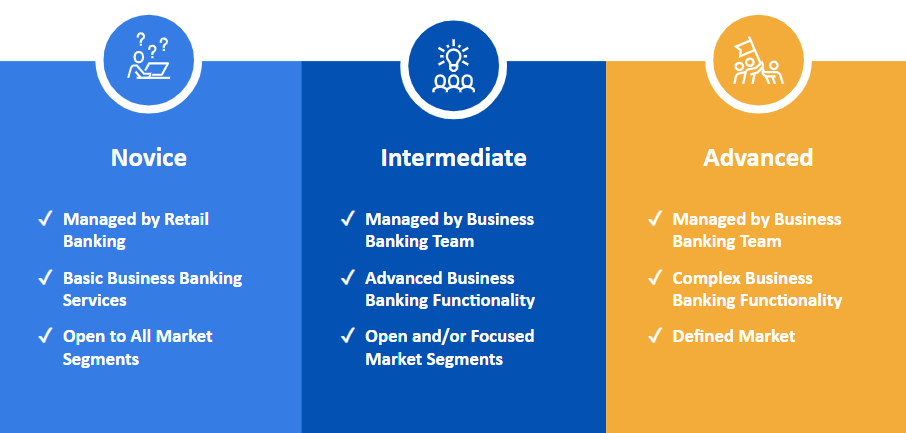Banks and credit unions are seeking to expand their business banking solutions to secure more deposits and boost revenue. In a recent webinar hosted by Alkami, experts Nicki Smith, deposit product development manager at Corning Credit Union; Kristin Bartels, digital banking & payment operations manager at Heartland Bank and Trust; and Jerry Adona, senior solution consultant at Alkami, shared invaluable insights on building and enhancing go-to-market plans.
Drawing from their expertise and real-world experiences, this blog outlines best practices to help financial institutions meet evolving expectations and gain a competitive edge in the market. As Jerry highlighted during the discussion, “This is not a program you can plug and forget. Business banking requires constant nurturing and alignment with your institution’s goals to remain successful and relevant.”
The primary motivators for financial institutions entering the business banking space include deposit growth, additional revenue opportunities, and competitive differentiation. Business clients tend to maintain higher balances and understand that quality services may come with fees, providing banks and credit unions a profitable revenue stream while deepening relationships.
Pro Tip: Constantly revisit and refine your go-to-market strategies. As Nicki noted, “We found that businesses were willing to pay for services, but we needed to ensure we had the right offerings to meet their needs.” Regularly assess your strategy to ensure it aligns with market demands and client expectations.
The journey to building a successful business banking program involves moving through three phases of development: Novice, Intermediate, and Advanced. At each stage, there are unique challenges and goals, from basic services to sophisticated treasury management solutions.

Pro Tip: Assess your financial institution’s current stage and set realistic goals for progression. Embrace a phased rollout approach, allowing your team to learn and adapt before scaling up. As Nicki put it, “We’re taking a crawl, walk, run approach, introducing foundational services first and scaling as we refine.”
A strong infrastructure for business banking hinges on compliance, risk management, and customer service capabilities. Successful institutions invest heavily in staff training, ensuring teams are equipped to meet regulatory standards and mitigate risk. Kristin emphasized the importance of compliance, noting, “Nacha rules are a cornerstone of our program, and we ensure all support staff complete annual training and certifications like Accredited ACH Professional (AAP).”
Key compliance elements to focus on include:
Pro Tip: Create a culture of learning across your team. Kristin highlighted Heartland Bank’s use of “train-the-trainer” sessions and branch-wide meetings to ensure alignment on products and compliance protocols.
Understanding the market and identifying viable segments within it are vital to building a targeted go-to-market approach. For instance, Corning Credit Union worked with consultants to analyze North American Industry Classification System (NAICS) codes and identify opportunities within their market, focusing on cash-heavy retailers and tourism sectors.
In addition, using internal data can uncover hidden opportunities. Kristin recommended analyzing account activity to identify companies operating out of consumer accounts, saying, “These accounts can often be transitioned into proper business banking solutions, opening doors to deeper relationships and higher revenue.”
Pro Tip: Conduct data audits to flag retail accounts with business-like behavior, then tailor outreach to transition these users into appropriate operating accounts.
A client-centric approach bridges the gap between frontline staff and specialized banking teams. Heartland Bank’s treasury management sales team exemplifies this by collaborating closely with branch staff to train them on identifying cues for business referrals. “Our frontline bankers and lenders are trained to recognize keywords and bring in the right experts,” Kristin explained.
Pro Tip: Foster open communication between teams and establish clear referral processes to enhance client experiences and improve conversion rates.
With high-value transactions and complex fraud risks, security is a cornerstone of business banking. Kristin emphasized, “When you’re processing millions in transactions, robust fraud and cybersecurity measures are non-negotiable.”
Recommended security measures include:
Pro Tip: Adopt layered security measures, such as automated fraud detection, check and ACH positive pay and real-time alerts, to prevent fraud in high-risk transactions and invest in educating your clients on cybersecurity best practices.
Introducing business banking solutions doesn’t need to be overwhelming. Starting small and scaling strategically ensures resource efficiency and client satisfaction. As Nicki explained, “We began by prioritizing ACH origination, wire transfers, and reporting, with plans to introduce more complex services like cash vaulting and lockbox in later phases.”
Pro Tip: Phase rollouts strategically, using initial feedback to refine services before expanding. This measured approach builds trust and confidence with clients.
Ongoing feedback is essential for fine-tuning your program. As Kristin shared, “Our fraud mitigation analytics not only protect customers but provide insights that help us refine and optimize our services.”
In addition, fostering a culture of transparency and partnership builds stronger client relationships. Nicki noted the value of having a consulting partner to navigate operational gaps and onboard clients smoothly, saying, “This collaboration has been critical to our success.”
Pro Tip: Regularly solicit client feedback through surveys, user groups, or advisory panels to identify areas for improvement and keep services aligned with business needs.
Developing a successful business banking program requires a blend of strategic planning, client-centric operations, and a commitment to continuous improvement. By following these best practices, financial institutions can strengthen their go-to-market strategies, boost revenue, and position themselves as trusted partners for clients.
Interested in learning more about launching, marketing, and growing a business banking program? Check out our virtual hub for a three-part webinar series with real-world insights from banks and credit unions. Discover practical strategies to elevate your business banking approach!
